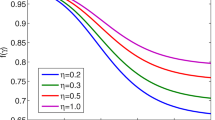Abstract
Method of moments has been a parameter estimation technique appropriate to calculate signal-to-noise ratio (SNR) estimates in fading channel models in which an optimal technique like maximum likelihood estimation is not mathematically tractable. In this article, the ratio of the second moment squared to the fourth moment of the received signal envelope is considered to calculate an exact expression for the SNR estimate in Nakagami-m fading channel for M-QAM and \(\theta \)-MQAM modulations as well as expressions to evaluate the variance and the mean of the estimate. The paper presents two useful contributions for SNR estimation theory on Nakagami fading. Besides the exact algebraic expression for the estimate for a generalized QAM modulation scheme, its performance is evaluated through a statistical linearization argument.








Similar content being viewed by others
References
Abramowitz, M., & Stegun, I. (1965). Handbook of mathematical functions (1st ed.)., National Bureau of standards applied mathematics series New York: Dover Publications.
Arfken, G. B., Weber, H. J., & Harris, F. E. (1985). Mathematical methods for physicists—A comprehensive guide (7th ed.). Waltham: Academic Press.
Arshad, A., & Hassan, S. A. (2014). SNR estimation in a non-coherent MFSK receiver with diversity combining. In International wireless communications and mobile computing conference—IWCMC (pp. 588–593). Nicosia.
Chen, F., Kang, Y., Yu, H., & Ji, F. (2014). Non-data-aided ML SNR estimation for AWGN channels with deterministic interference. EURASIP Journal on Wireless Communications and Networking, 2014(1), 45.
Cho, K., & Yoon, D. (2002). On the general BER expression of one and two-dimensional amplitude modulations. IEEE Transactions on Communications, 50(7), 1074–1080.
de Souza, R. A. A., Cogliatti, R., & Yacoub, M. D. (2014). Efficient acceptance-rejection method for Nakagami-\(m\) complex samples. IEEE Wireless Communications Letters, 3(1), 94–96.
Dianat, S. A. (2007). SNR estimation in Nakagami fading channels with arbitrary constellation. In IEEE international conference on acoustics, speech and signal processing—ICASSP (Vol. 2, pp. 325–328). Honolulu: IEEE.
Diaz, M. A., Valcarce, R. L., & Mosquera, C. (2010). SNR estimation for multilevel constellations using higher-order moments. IEEE Transactions on Signal Processing, 58(4), 1515–1526.
Elezabi, A., & Gomaa, A. (2008). Diversity combining and SNR estimation for turbo-coded frequency-hopped spread-spectrum in partial-band interference and fading channels. In IEEE international symposium on personal, indoor and mobile radio communications—PIMRC (Vol. 19, pp. 1–5). Cannes.
Gradshteyn, I. S., & Ryzhik, I. M. (2007). Table of integrals, series and products (7th ed.). Burlington: Elsevier.
Hafez, M., Khattab, T., & Shalaby, H. M. (2015). Blind SNR estimation of Gaussian-distributed signals in Nakagami fading channels. IEEE Transactions on Wireless Communications, 14(7), 3509–3518.
Ijaz, A., Awoseyila, A. B., & Evans, B. G. (2012). Signal-to-noise ratio estimation algorithm for adaptive coding and modulation in advanced digital video broadcasting-radar cross section satellite systems. IET Communications, 6(11), 1587–1593.
Javidi, S., Mandic, D. P., Took, C. C., & Cichocki, A. (2011). Kurtosis-based blind source extraction of complex non-circular signals with application in EEG artifact removal in real-time. Frontiers in Neuroscience, 5, 105.
Karagiannidis, G. K., Zogas, D. A., & Kotsopoulos, S. A. (2003). On the multivariate Nakagami-\(m\) distribution with exponential correlation. IEEE Transactions on Communications, 51(8), 1240–1244.
Kay, S. M. (2013). Fundamentals of statistical signal processing: Estimation theory (1st ed., Vol. 1). Upper Saddle River: Prentice Hall.
Kim, K., Kim, Y., Pack, S., & Choi, N. (2011). An SNR-based admission control scheme in WiFi-based vehicular networks. EURASIP Journal on Wireless Communications and Networking, 2011(1), 204.
Mohammad, M., & Buehrer, R. M. (2005). On the impact of SNR estimation error on adaptive modulation. IEEE Communications Letters, 9(6), 490–492.
Olver, F. W .J., Olde Daalhuis, A. B., Lozier, D. W., Schneider, B. I., Boisvert, R. F., Clark, C. W., Miller, B. R., & Saunders, B. V. (2016). NIST digital library of mathematical functions. http://dlmf.nist.gov, Release 1.0.14 of December 21, 2016.
Pappi, K. N., Lioumpas, A. S., & Karagiannidis, G. K. (2010). \(\theta \)-QAM: A parametric quadrature amplitude modulation family and its performance in AWGN and fading channels. IEEE Transactions on Communications, 58(4), 1014–1019.
Proakis, J. G., & Salehi, M. (2001). Digital communications (5th ed.). New York: McGraw-Hill Higher Education.
Sastry, K. S., & Babu, M. S. P. (2013). Non data aided SNR estimation for OFDM signals in frequency selective fading channels. Wireless Personal Communications, 70(1), 165–175.
Savaux, V., Louët, Y., Djoko-Kouam, M., & Skrzypczak, A. (2013). Application of a joint and iterative MMSE-based estimation of SNR and frequency-selective channel for OFDM systems. EURASIP Journal on Advances in Signal Processing, 2013(1), 128.
Talakoub, S., & Shahrrava, B. (2006). Turbo equalization with integrated SNR estimation. In Annual IEEE globecom conference (Vol. 27, pp. 1–5). San Francisco: IEEE.
Wiesel, A., Goldberg, J., & Yaron, H. M. (2006). SNR estimation in time-varying fading channels. IEEE Transactions on Communications, 54(5), 841–848.
Yacoub, M. D. (2007). The \(\kappa -\mu \) distribution and the \(\eta -\mu \) distribution. IEEE Antennas and Propagation Magazine, 49(1), 68–81.
Yacoub, M. D., Vargas, J. E. B., & de R. Guedes, L. G. (1998). On the statistics of the Nakagami-\(m\) signal. In: SBT/IEEE international telecommunications symposium (Vol. 2, pp. 377–382). São Paulo: IEEE.
Acknowledgements
The authors would like to thank CNPq for the financial support to the work.
Author information
Authors and Affiliations
Corresponding author
Ethics declarations
Conflict of interest
On behalf of all authors, the corresponding author states that there is no conflict of interest.
Rights and permissions
About this article
Cite this article
Queiroz, W.J.L., Almeida, D.B.T., Madeiro, F. et al. New closed-form expressions for SNR estimates of Nakagami fading channels by the method of moments. Telecommun Syst 69, 321–333 (2018). https://doi.org/10.1007/s11235-018-0440-6
Published:
Issue Date:
DOI: https://doi.org/10.1007/s11235-018-0440-6




